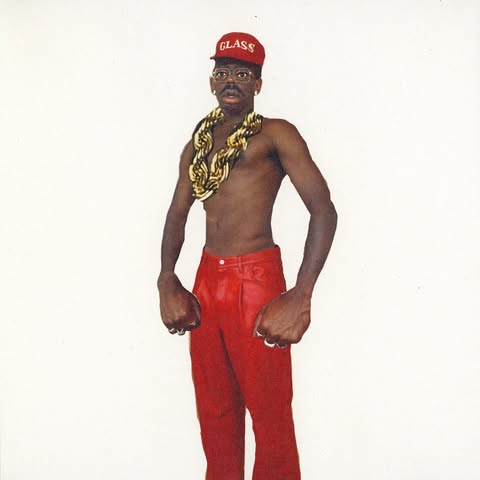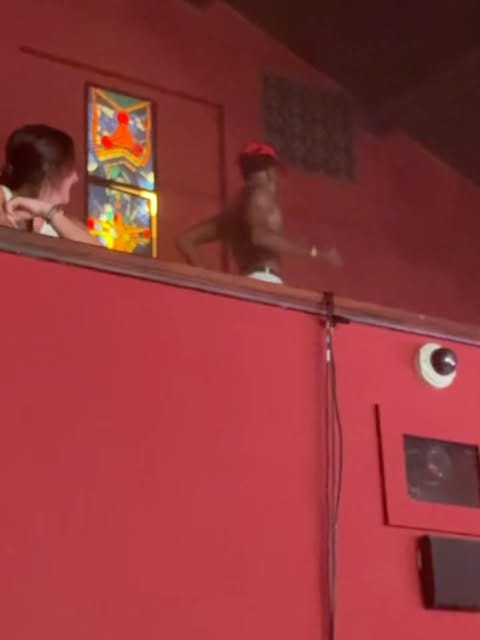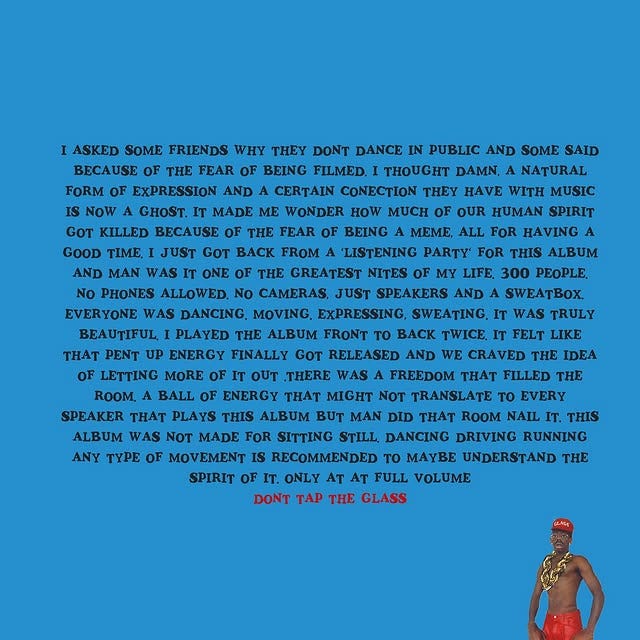Tyler, the Creator Puts up a Wall in “DON’T TAP THE GLASS”
Is this sudden release a simple dance album or something more personal?
Rule number one: Body movement, no sitting still. Rule number two: Only speak in glory, leave your baggage at home. Rule number three: Don’t tap the glass.
On Wednesday, July 16th, Tyler, the Creator’s social media pages began teasing the release of new music a mere five days later, on July 21st. Initially, fans believed this release might be a new single, possibly even a deluxe edition of Chromakopia– the album that had been released less than nine months earlier and over three years after his 8th studio album, Call Me If You Get Lost.
However, Tyler proceeded to shock everyone a few days later when he posted multiple images all containing a distorted version of himself wearing bright red pants, comically large gold jewelry, and a red hat with white text reading “GLASS.” Each post had the same aggressively capitalized demand in the caption, “DON’T TAP THE GLASS.”
What is the Glass?
At face value, this album is a stark contrast to the intimate lyricism of Chromakopia, a love letter from Tyler to his mom, his roots, and his past lovers. Understandably, Tyler seems to have wanted to make a project where he didn’t bear his soul to an audience of strangers. The marketing emphasizes this, framing DON’T TAP THE GLASS as a lighthearted album made for the sole purpose of dancing. He stresses that this album is “MADE FOR BODY MOVEMENT/ FULL VOLUME."
This lighthearted concept has raised the question, “What is the glass?” To answer this, one needs to examine Tyler’s character for this album—a disproportionate, exaggerated version of him, wearing a thick gold chain, red pants, and a red baseball cap, trapped behind glass.
The thick gold jewelry and red pants are a clear reference to LL Cool J in the “I’m Bad” music video, someone who defined the visual language of hip-hop artists in the 1980s. His style characterized how many rap artists want to be perceived—a mixture of streetwear and luxury, of where they’ve been and where they are now.
This homage demonstrates that DON’T TAP THE GLASS is meant to be a return to the classic sounds of 80s hip-hop. Tyler utilized upbeat instrumentation, creative sampling, and deceptively complex lyricism to create something akin to the energetic dance albums of the 80s.
Tyler’s dramatically exaggerated outfit also establishes him as one of the greats in hip-hop. This is evident in the many braggadocious songs on the album, where Tyler celebrates his insane level of success.
In “Tell Me What It Is,” Tyler calls out other rappers for using him for his fame: “Yeah, bro, yeah, bro, bounce them shoulders 'til you're dead.”
In this sense, “don’t tap the glass” seems to be a warning to his peers not to use him for his fame and talent. Tyler frames himself as an aggressive animal stuck behind a wall of glass that, if tapped, is going to make him explode with anger and violence.
This is most clearly shown in “Don’t Tap That Glass/Tweakin’” where he frames the title as a threat: “Don't tap that glass, don't tap that glass/There's a monster in it.”
Tyler appears to have grown tired of wearing his heart on his sleeve in his music, so, instead, he created something a bit more on the egotistical side that people could dance and sing along to. However, upon closer examination of the lyrics, subtle cracks in this carefree facade begin to appear.
A Crack Forms
Although most of the lyrics on DON’T TAP THE GLASS are Tyler bragging about his success and teasing other rappers for being reliant on him, there are a few songs where genuine frustration and anguish appear. These are usually concerning his strenuous love life.
The first hint of Tyler’s sensitive side is at the midway point of the album, in the song “Ring Ring Ring.” Looking beyond the song’s buoyant beat and catchy chorus, one can hear the desperation in Tyler’s lyrics about yearning to reconnect with a past lover he knows he shouldn’t be calling:
“I had to protеct my heart/And build the wall so tall, I couldn't look over (Don't lеt me catch you here)/I need to touch you (One more time).”
Tyler seems to grapple with the struggle of wanting connection while knowing this person hurt him in the past, making him build a wall similar to that in the album art. In this context, “don’t tap the glass” seems to be a reminder to Tyler more than the listener. He is telling himself not to tap the glass of his phone and reach out to someone who will leave him suffering.
The inclusion of this intimate lyricism is particularly interesting given one of the rules for the album: “Leave your baggage at the door.” Resting in the middle of the album, this song could signify a slight shift in tone. The first five songs are hostile, with Tyler shouting about other rappers being “weird” and him getting his “paper up.” There is a large focus on his monetary success, with mentions of expensive jewelry, cars, and selling out shows. Despite this, Tyler can’t ignore what he is lacking—real connection:
“Before you go and walk out my life/I wanna tell ya (Tell you)/How much I love you, I love you/I love you, I love you/I love you, I love you/I love you, I love you (And I cannot give it up)”
Two songs later, in “I’ll Take Care Of You,” the mix of Tyler’s lyrics and samples illustrates his juxtaposing attitudes throughout the album. The sample proclaims, “Fuckin' with no hoes, ain't never been no lame” while Tyler begs to take care of someone he loves:
“Wait a minute, I'm goin' through some shit/I can tell it's not beginning to work/Stay, hey/I'll take care of you.”
Making the Wall
Tyler is demanding that those around him not tap the glass because he doesn’t want to be hurt, whether it be professionally, personally, or romantically. In some songs, the title is a threat not to mess with him and his success, while in others it is a desire to remove himself from being hurt by those in his personal life. Either way, he is trying to hide his emotional vulnerability behind a tough front.
The art of his large, detailed hands, bunched up into tight fists, may be a visual hint of this internal struggle. He stands in an uncomfortable pose that emphasizes his fists, showing that this album is him on the offensive. This aspect of the art may reveal that Tyler is trying to hide his feelings behind fast-paced songs, expensive jewelry, lively dancing, and a nonchalant exterior.
Throughout his discography, this back-and-forth has been evident, but he rarely makes a deliberate effort to hide his feelings throughout an entire body of work. The cracks always burst forth into a raw, emotional ballad. Still, this album doesn’t reach that moment of catharsis, highlighting the overarching theme of hiding behind a box of glass. The walls are transparent, but his persona is not.
Regardless of any concealed meaning, the main intention behind this album remains at the forefront of the listening experience. Tyler wanted to create a space where people could dance and feel the music without fear of judgment.
“I just got back from a ‘listening party’ for this album, and man, was it one of the greatest nights of my life. 300 people. No phones allowed. No cameras. Just speakers and a sweatbox. Beautiful.”
This article is a written contribution by Grace Myatt.






